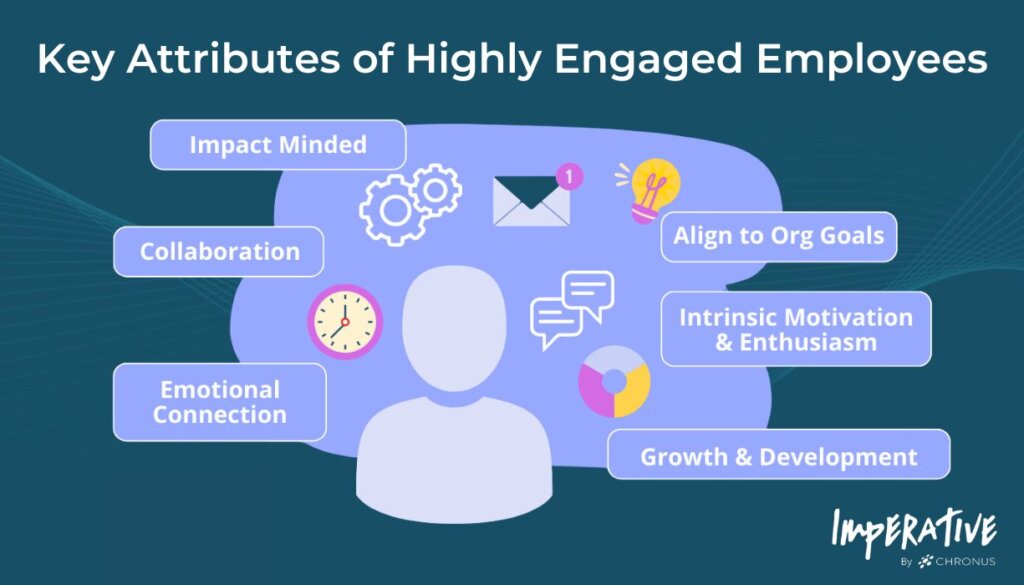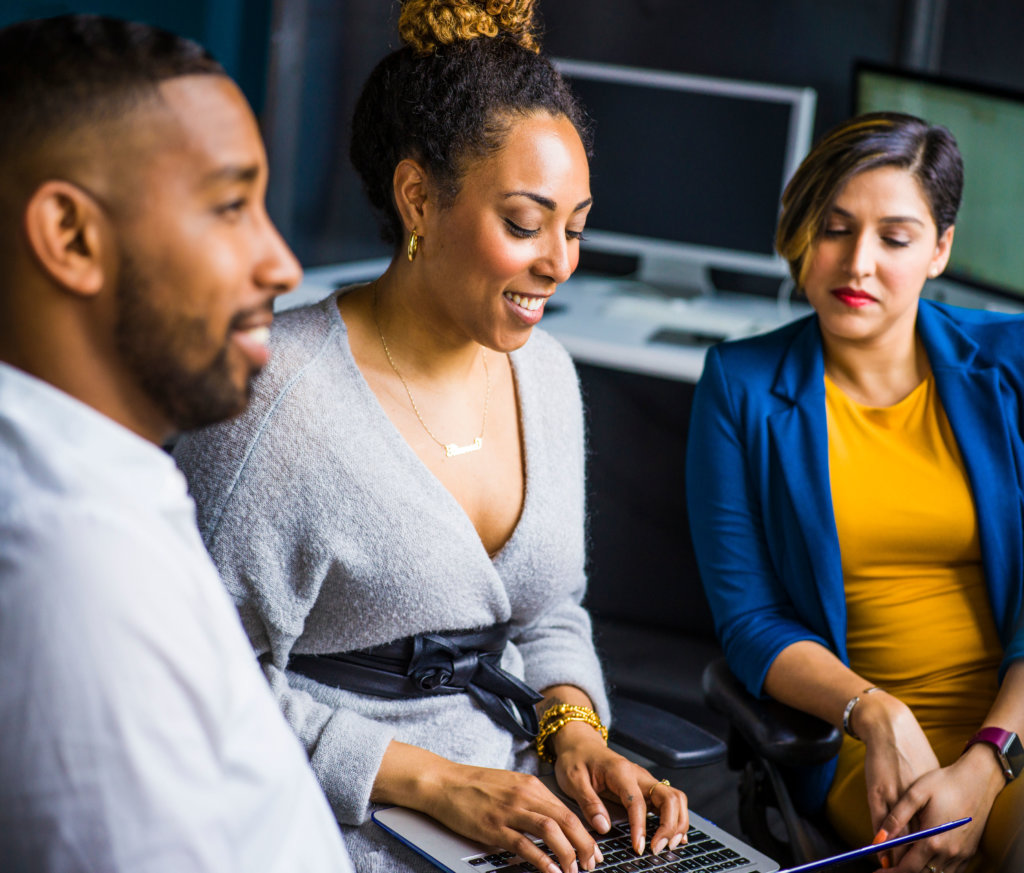Employee engagement is one of the most important and most prioritized aspects of a business. A recent Gallup poll found that 87% of employees are not engaged in their work, meaning they are not involved in, enthusiastic about or committed to their work or workplace. This lack of engagement costs U.S. companies $450 billion per year in productivity.

When you put in the work to create robust employee engagement strategies, you are enabling your employees’ commitment to their work and the company’s values, while helping your organization meet its goals.
What Is Employee Engagement?
Employee engagement describes to what extent employees are invested in their work and the success of the organization. Organizations go to great lengths to measure and influence engagement given the immense impact it has on an organization’s success. At its core, employee engagement is a choice that each employee makes every day.
From the human perspective, it’s our willingness as people to apply ourselves toward achieving positive outcomes for the organization we work for. It’s visible through our actions and it encompasses our energy, intellect, intent, and behavior. We as individuals decide to what level we are willing to engage.
What Is an Employee Engagement Strategy?
Employee engagement is essentially a workplace approach that aims to ensure excellent working conditions and a purposeful experience for every member of an organization. Working under the right conditions, employees are much more likely to give their best every single day. Engaged workers are more committed to the values and goals of their organization, motivated to contribute to a company’s success and have a better sense of their well-being. This contributes to a sense of community for remote employees, as well as in-person or onsite employees. Building a strategy of programs and tactics that entice and enable engagement, help endear people to an organization and build employee fulfillment, increasing employee retention and productivity.
Why Should You Prioritize Employee Engagement Strategies?
As an employer, employee engagement means encouraging positive behaviors and actions that lead to improved business outcomes. You want your employees to feel proud of the work that they do while staying loyal to the company. Having dedicated, driven workers on your team leads to positive business outcomes like:
Increased Profits
In business, every decision comes back to the bottom line. A Gallup workplace study found organizations with highly engaged workforces outperform their competitors by 147% in earnings-per-share and enjoy 21% percent higher profitability. Understanding the impact of employee engagement strategies on your business’s profitability is especially important during uncertain cultural or financial times.
In fact, Gallup’s study found that employee engagement is an important predictor of company performance even during a recession.Jim Harter, Ph.D. and Gallup’s Chief Scientist of workplace management and well-being practices says, “When you ask people about their intentions during a recession, it’s pretty clear that disengaged workers are just waiting around to see what happens. Engaged workers, though, have bought into what the organization is about and are trying to make a difference. This is why they are the most productive workers.”
Improved Customer Experience
The mentality of your employees can directly impact how they interact with customers. A study conducted by Washington State University determined employee job satisfaction and engagement is directly related to customer satisfaction.When your employees are engaged with their work, they do more for your customers. They strive to ensure a positive customer experience because they believe in the goals and mission of your organization. Northwestern University found that organizations whose employees are engaged with their work have customers who use the company’s products and services more often and with higher satisfaction than customers of companies with disengaged employees.
Increased Retention
Engaged employees feel appreciated, which is an important driver of employee retention. A PayScale study found employees who felt appreciated by their company were almost 11 times more likely to be engaged with their work. You can show your appreciation for your employees with strong programs for support and development.
During times of social unrest and financial uncertainty, employee engagement efforts can help improve retention because your employees will believe in the future success of your business and want to do everything they can to contribute to that success. And, when you put in the work to help prevent unnecessary turnover, you can save your organization significantly when it comes to the costs of hiring, onboarding and training.
Competitive Hiring
More workers than ever are actively engaged looking for new work or watching job openings. In fact, 51% of workers are seeking new opportunities and, with growing financial uncertainty, that number could continue to increase. Building a reputation for having a culture of inclusion, development and overall support can help your organization set itself apart from others in your field.
Higher Innovation and Creativity
Engaged employees are also more likely to contribute innovative ideas and solutions to the group because they feel valued. By empowering employees to share their insights and take risks, you can drive continuous improvement and foster a company culture of innovation.
A Stronger Culture
Finally, engaged employees contribute to a positive and inclusive organizational culture. They embody the values and mission of the organization and serve as ambassadors both internally and externally. In doing so, they inspire and motivate their colleagues, creating a ripple effect that permeates the entire organization and attracts top talent.
9 Effective Employee Engagement & Retention Strategies
When you are concerned about the level of engagement among your workers, there are a few things you can do to help foster an environment in which employees feel more invested in their work and your organization. If you can cultivate an environment where you prioritize the growth and development of your employees, you can help build a culture of trust and communication. Here are just a couple examples of strategies for improving employee development and engagement:
Offering Competitive Salaries and Benefits
Providing competitive compensation is a basic move for both engagement and retention. While high pay may not be enough to keep an employee if they’re truly unhappy, you do need to make sure your salaries and benefits keep pace with the market and equity standards so you can attract the best talent and keep them.
Good employees won’t feel valued or stay engaged if they know they aren’t being compensated fairly—and they probably won’t stay around at all if they know they can go elsewhere for a better pay/benefits package.
Providing Opportunities for Growth and Development
According to a Conference Board survey, 96% of employees say it’s important for them to develop their skills, and 58% say they are likely to leave their company if they lack these opportunities. Employees who are learning and growing are much more likely to be engaged and to have a reason to commit to the organization. Professional development can include further education, leadership or skills training, or mentoring.
Career Pathing
Career pathing is an aspect of professional development that is key for retention. An employee’s career development is no longer a ladder that only moves up, but instead encompasses a number of different path options; think more lattice than ladder. Communicating growth paths within a company helps employees see their future potential.
The career pathing process shows employees how they can move up or laterally in your organization and allows them to have some say in what they want to do in their career. It will also help them and their manager identify the skills and knowledge they’ll need to obtain to get there. Career pathing creates opportunities for employees and managers to collaborate, identifying milestones that will assist the employee in reaching that next level or promotion
Recognizing and Rewarding Good Performance
So much of employee engagement strategy comes down to communication between you and your workers. Recognizing employees in front of others shows that you see people and their individual efforts within the organization. These programs can be in-person or digital, through the company’s Intranet, social media channels, at company all-hands or through email communications. This type of employee recognition can also inspire others to work harder and engage in new ways throughout the company.
Showing you notice and appreciate employees’ work builds a culture of trust and mutual respect that improves engagement. And when employees feel appreciated, they will be more likely to stay with your company for the long haul.
Creating a Positive Work Culture
When a company has a positive work culture—such as an environment where employees are treated with respect, teamwork is valued, people feel free to be themselves and expectations are clear and reasonable—employees enjoy coming to work. This means minimizing bias, microaggressions and increasing collaboration between colleagues and across teams and functions.
In a positive work culture, employees also need to feel they can bring challenges or culture weaknesses to senior leaders in a way that will be received and taken seriously. When they have positive interactions with co-workers and managers, feel appreciated and aren’t chronically overstressed, they are much more engaged in the workplace, and this increases retention as well.
Organizations can foster a positive culture by listening to employees, promoting diversity and inclusion, providing opportunities for connection and teamwork, making sure the reality of the culture matches up with its marketing, outlining clear goals, offering career-enhancing opportunities and more.
Get mentoring resources straight to your inbox. Subscribe today!
Promoting Work-life Balance
Employees who can’t achieve a doable work-life balance are in danger of burning out—the opposite of engagement. All work and no play (or time to take care of personal matters) is unsustainable and leads to high turnover as employees seek an environment where they can thrive. Organizations can promote balance with initiatives by making it clear that they recognize the importance of employees’ personal lives. Initiatives can include:
- Flexible work arrangements
- Wellness programs
- Opportunities to confide in a mentor
- Generous time off policies
Providing Clear Communication and Feedback
Employees are more likely to stay engaged and committed to a workplace if they feel they are being heard, so transparent communication is crucial.
Showing employees that your organization is open to candid and constructive feedback is a great way to initiate a dialogue with your workforce. From performance reviews to weekly one-on-one’s, companies are always giving employees feedback. It’s important to make sure feedback is a two-way street. Setting up forums or regular employee engagement surveys to solicit feedback is a great way to open that conversation.
But asking for feedback is just the first step. You also need to acknowledge the feedback you’ve received, and illustrate what you’ll be doing with that feedback. Be transparent about the feedback you’re acting on, why you might not be acting on other aspects of feedback. Asking for feedback allows your employees to feel they have a say in the direction of the company, as well as company culture.
Mentoring
There are many ways to improve your employee engagement strategies, from compensation increases to improved benefits. But, one of the most significant ways to improve your employee engagement plan is to invest in education and development. Establishing a mentoring program is a cost-effective way to improve employee engagement. In fact, more than 71% of Fortune 500 companies offer corporate mentoring programs.
Mentoring can help increase employee engagement levels by solving challenges related to inclusion, development and support:
- Inclusion: Promotes open communication, improves collaboration and increases interaction across all demographics within your organization.
- Development: Invests in the success of employees. Businesses on the Fortune 100 “Best Companies” list provide almost double the number of training hours for full-time employees and saw 65% lower turnover than other businesses in the same sectors.
- Support: Encourages camaraderie among employees, leading to support networks. Gallup found a concrete link between having friendships at work and employee engagement.
With the Chronus mentoring platform, we look to the Employee Experience Circle to help determine the most effective mentoring program to offer.
No matter where an employee falls in this circle, there are many options when it comes to how to foster employee engagement. No matter what tactics you choose, be sure they include goal-setting and peer feedback on an ongoing basis.
Here are just some of the strategies we recommend:
- Career Mentoring: Helps prevent employee stagnation overall
- Reverse Mentoring: Bridges generations and encourages knowledge sharing to prevent stagnation
- Flash Mentoring: Allows employees to learn from experts in numerous subject areas
- Mentoring Circles: Peer-to-peer mentoring enables employees to learn and develop together as a group
Additionally, you would be wise to consider virtual mentoring as an option, in the wake of the hybrid workplace. Virtual mentoring could be an ideal strategy for improving employee engagement even when you aren’t in the office together. It can help you connect your employees when they are most at risk of feeling isolated.
Developing Managers to Support Teams
Studies show the biggest influencer of employee engagement is the direct manager. There is substantial focus on managers driving productivity, yet many managers struggle to develop the foundational trust and rapport with their team members to be a positive influence on engagement. Training and development programs for managers can equip them with the necessary skills to support their teams and enhance overall employee engagement.
These programs should include training on effective communication, conflict resolution, and emotional intelligence. Regular workshops and seminars can help managers stay updated on best practices for team management. Additionally, providing mentorship opportunities where experienced leaders guide new managers can be invaluable. Encouraging managers to set clear goals, give constructive feedback, and recognize team achievements fosters a positive work environment. By investing in these areas, companies can ensure their managers are well-equipped to support and engage their teams effectively.
The Challenges of Employee Engagement
Today’s dynamic work environment does not make employee engagement easy. Building and maintaining high levels of employee engagement is a complex endeavor and the nuances and factors in current work settings provide additional obstacles.
While there are many barriers to high connection and engagement, recognizing the challenges that apply to your specific organization is the first step toward implementing strategies and utilizing tools that can address them.
Remote and Hybrid Employees
The rise of remote work has introduced new challenges in fostering engagement. When employees work from different locations, there can be a sense of isolation and disconnection from the rest of the team and the organization.
Diversity of Needs
Many organizations operate with diverse and multicultural teams, which can present communication and engagement barriers. Differences in language, cultural norms, and working styles are natural, which require organizations to recognize that engagement needs may be different.
Change Fatigue
Organizations are constantly changing. That said, the past few years have pushed many organizations into overdrive. There is so much change in motion, that employees become numb to it and confused by what’s behind all of it. It makes engaging in work harder when everything is in constant flux.
Lack of Communication and Feedback
Communication breakdowns and insufficient feedback channels can significantly impact employee engagement. When employees don’t receive regular and constructive feedback, they may feel undervalued or uncertain about their performance.
Limited Employee Recognition and Rewards
A lack of recognition and rewards can contribute to decreased engagement. When employees’ efforts and achievements go unnoticed, they may become disengaged and unmotivated.
How to Develop Your Employee Engagement Program
A strong employee engagement program builds a motivated workforce, improves retention, and drives company success. Here’s how to develop a structured, results-driven approach.
Set Goals & Align to Organizational Objectives
Start with clear, measurable goals that align with business objectives. Define what success looks like—whether it’s increasing engagement scores, improving retention, or strengthening company culture. With specific goals in place, you can create a focused strategy and track progress effectively.
Break your goals down into short-term and long-term objectives to ensure steady progress. Assign clear ownership of engagement initiatives so teams know who is responsible for driving each effort.
Make sure these programs align themselves with the goals and company core values of the organization. This way employees see their work as contributing to the larger purpose and mission of the company. This alignment fosters a sense of ownership and responsibility, as employees feel they are integral to achieving organizational success.
Get Employee Input
Engagement programs work best when employees have a voice in shaping them. Gather input through surveys, focus groups, or direct conversations. Understanding their needs and motivations will help create initiatives that truly resonate.
Use anonymous surveys to encourage honest feedback without fear of repercussions. Follow up with small group discussions to dive deeper into key themes and concerns.
Communicate & Empower
Transparency is key. Keep employees informed about engagement initiatives and encourage participation. Managers should actively promote engagement efforts and create opportunities for employees to take ownership, whether through mentorship programs or culture-building activities.
Use multiple communication channels, such as town halls, email updates, and internal social platforms, to ensure employees stay informed. Recognize and reward employees who actively contribute to engagement efforts to encourage wider participation.
Set Up Feedback Loops
Engagement isn’t a one-time effort. Establish regular feedback channels, such as quarterly surveys or one-on-one check-ins, to gauge employee sentiment. Most importantly, act on the feedback so employees see their input making a difference.
Create a structured system for reviewing and implementing employee suggestions. Share updates on actions taken based on feedback to build trust and demonstrate a commitment to continuous improvement.
Set Up Tracking and Measure Employee Engagement Results
In order to know how your organization is performing on retention and engagement, you need to measure them. Tracking engagement data helps you understand what’s working and what needs improvement. Monitor key metrics like retention rates and participation in engagement initiatives. Use this data to adjust your strategy and ensure long-term success.
- Employee retention is quantified as the percentage of employees who remain at a company for a fixed time period. It’s normally measured annually. You can also measure retention for specific roles, employee demographics or specific teams. It can also be broken down into voluntary vs. involuntary exits.
While retention numbers are generally easily measured and fairly straightforward, the real intelligence is in the “why” retention is increasing or decreasing. To understand these drivers, you need to get personal feedback from employees. This is often accomplished via employee surveys that gauge levels of employee job satisfaction and engagement. Analyzing the numbers and incorporating employee feedback can help your organization identify problems and take proactive steps to grow engagement and retention rates.
Compare engagement data across different teams and departments to identify trends. Set benchmarks based on industry standards to assess how your organization stacks up against competitors.
Use Software to Make This All Easier
Technology simplifies engagement efforts. Platforms can automate surveys, track participation, and provide real-time insights. With the right tools, you can manage engagement more efficiently and make data-driven decisions.
Leverage AI-driven analytics to predict disengagement risks and personalize engagement initiatives. Integrate engagement software with existing HR systems to streamline data collection and reporting. By involving employees, tracking progress, and leveraging technology, you can create a workplace where employees feel valued and engaged.
Qualities For Successful Employee Engagement Strategies
How will you know if your employee engagement strategies are striking the right tone? Here are a few qualities you can strive for:
- Transparent
- Empowering
- Purposeful
- Responsive
- Emotionally Connected
- Motivating and Enthusiastic
- Aligned to Organizational Goals
- Impact-Minded
- Enabling Growth and Development
- Collaborative
By embedding these qualities into your employee engagement strategies, you can foster a workplace culture where employees feel valued, inspired, and committed to both their personal growth and the organization’s success.
What Engagement Means to Your Employees
For employees, having a good engagement experience means that they will wake up excited for work. They will bring new ideas and experiments with them. Your employees will have a clear understanding of their role in the organization, and understand how their role plays a part in making a difference. They will feel like an essential member of the team, which can build loyalty and ties to a company.
When your workers have a high level of trust and dedication to you, they are not only happier themselves, but they will be more productive in the work that they do.
Create Better Employee Engagement Strategies with Chronus
Creating better employee engagement with Chronus starts with understanding the value of connection and development in the workplace. Chronus offers a powerful mentoring platform and Employee Resource Group (ERG) software designed to foster meaningful relationships, enhance professional growth, and build a company culture of inclusivity. By leveraging advanced matching algorithms, automated workflows, and robust analytics,
Chronus helps organizations implement and manage mentoring and ERG programs that drive engagement and retention. Employees feel more connected, supported, and motivated, leading to a more dynamic and productive workplace. By implementing these employee engagement strategies, your employees can feel confident in your organization’s dedication to their growth and development. Prioritizing your employees in this way boosts morale and leads to better engagement across the board.
To learn more, check out our eBook, “Mentoring: Humanizing the Employee Experience” today.




